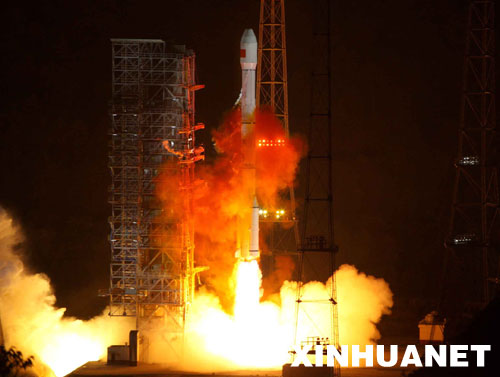
China's first data relay satellite "Tianlian I" is launched on a Long March-3C carrier rocket from the Xichang Satellite Launch Center in southwest China's Sichuan Province on Friday, April 25, 2008. [File Photo: Xinhuanet]
China has made a breakthrough in developing its next generation of space-launch vehicle Long March V, which is scheduled for operation by 2014, said sources with the nation's launch vehicle academy.
Significant progress has been made on the rocket engine and the building of a production plant.
The rocket's 120-tonne liquid oxygen-kerosene engine had passed initial tests and would be put into field tests by the year end, said Liang Xiaohong, vice president of the China Academy of Launch Vehicle Technology.
Li Hong, president of the launch vehicle academy, said the Long March V would meet the requirement of large-payload low Earth orbit (LEO) and geosynchronous transfer orbit (GEO) missions for the next two to three decades.
With four boosters, the 59.5-meter-high environmentally friendly rocket's launching weight would reach 643 tonnes. It would be able to deliver a 25-tonne payload to an LEO, compared with the present 10 tonnes, and a 14-tonne payload to a GEO, compared with 5.5 tonnes now, said China Central Television in a report.
The 14-tonne payload to a GEO means the rocket can carry a heavier satellite or more satellites at one time while the 25-tonne payload to an LEO will enable it to carry the Shenzhou-series spacecraft, said Li Dong, a designer of Long March V.
The rocket is five meters wide and cannot be transported via railway or expressway to any of the nation's current launch centers. As a result, a production plant has been built in the coastal Tianjin where the rockets will be shipped by sea to a new launch facility at Wenchang in the southern province of Hainan.